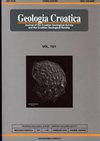作为地下水风险评估基础的硬岩层脆弱性方法——从资源到水源
IF 1.1
4区 地球科学
Q3 GEOLOGY
引用次数: 0
摘要
坚硬岩层中的地下水在潜在水源排放污染物到达含水层饱和区的地方是最危险的。在这种情况下,保护地下水的一个重要工具是污染风险图。这张地图是基于两张地图的整合:一张危险地图,即潜在污染源地图和一张脆弱性地图。选择合适的脆弱性方法是一项重要的任务,因为最终得到的脆弱性图会对污染图的最终风险产生重大影响。在塞尔维亚西部塔拉国家公园的个案研究中考虑了地下水脆弱性评价的最适当方法。采用了四种常用的内在漏洞图评估方法:DRASTIC、EPIK、PI和COP。各种方法在评价脆弱性程度时绘制的脆弱性图不同,从而影响地下水污染风险图。应用研究提供了如何在特定区域评估污染风险的一个例子。对塔拉国家公园区域所获得的结果的比较表明,考虑到研究区域的所有具体情况,PI方法作为一种平衡良好的方法更受青睐。还对现有污染源集水区评估的风险进行了详细分析,以指出可能的污染源,并确认所建立的脆弱性和风险图的准确性。所进行的研究强调必须采用一个明确的概念水文地质模型,并同时应用几种方法来确定每个地区的最佳水文地质模型。本文章由计算机程序翻译,如有差异,请以英文原文为准。
Vulnerability methods in hard rock formation as a basis for groundwater risk assessment – from resource to source
Groundwater in a hard rock formation is most endangered at places where a potential source can discharge contaminants that can reach the saturated zone of an aquifer. In these circumstances, an essential tool for groundwater protection is the contamination risk map. This map is based on the integration of two maps: a hazards map, i.e., map of potential sources of contamination and a vulnerability map. The selection of a proper vulnerability method is an important task since the resulting vulnerability map can significantly impact the final risk of contamination map. The most appropriate method for groundwater vulnerability assessment was considered in the case study of Tara National park, in Western Serbia. The four commonly used methods were applied to assess the intrinsic vulnerability maps: DRASTIC, EPIK, PI and COP. All the applied methods resulted in different vulnerability maps in assessing the degree of vulnerability, consequently influencing the groundwater contamination risk maps. The applied research presents an example of how contamination risk should be assessed in a specific area. Comparison of the results obtained for the area of Tara National Park indicates the preference of the PI method as a well-balanced method, taking into account all the specifics of the study area. A detailed analysis of the assessed risks in the catchments of the existing sources was also conducted to indicate probable sources of contamination and confirm the degree of accuracy of the created vulnerability and risk maps. The conducted research emphasizes the necessity to adopt a clear conceptual hydrogeological model and to apply several methods simultaneously to determine the optimal one for each individual area.
求助全文
通过发布文献求助,成功后即可免费获取论文全文。
去求助
来源期刊

Geologia Croatica
GEOSCIENCES, MULTIDISCIPLINARY-
CiteScore
2.90
自引率
23.10%
发文量
35
审稿时长
>12 weeks
期刊介绍:
Geologia Croatica welcomes original scientific papers dealing with diverse aspects of geology and geological engineering, the history of the Earth, and the physical changes that the Earth has undergone or it is undergoing. The Journal covers a wide spectrum of geology disciplines (palaeontology, stratigraphy, mineralogy, sedimentology, petrology, geochemistry, structural geology, karstology, hydrogeology and engineering geology) including pedogenesis, petroleum geology and environmental geology.
Papers especially concerning the Pannonian Basin, Dinarides, the Adriatic/Mediterranean region, as well as notes and reviews interesting to a wider audience (e.g. review papers, book reviews, and notes) are welcome.
 求助内容:
求助内容: 应助结果提醒方式:
应助结果提醒方式:


